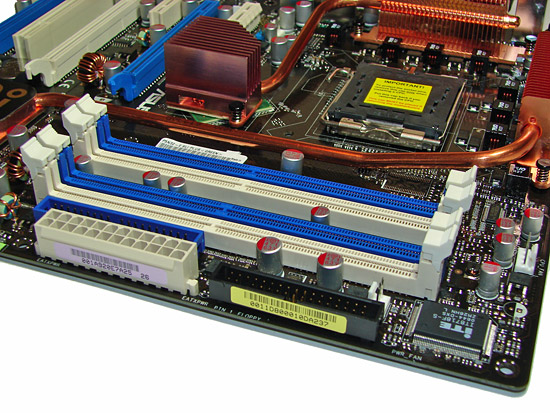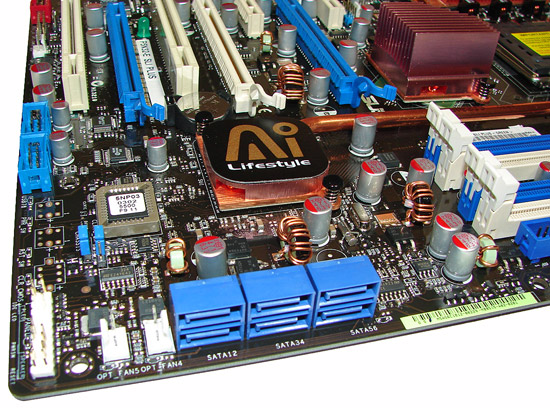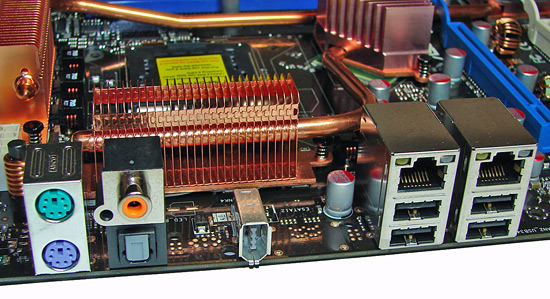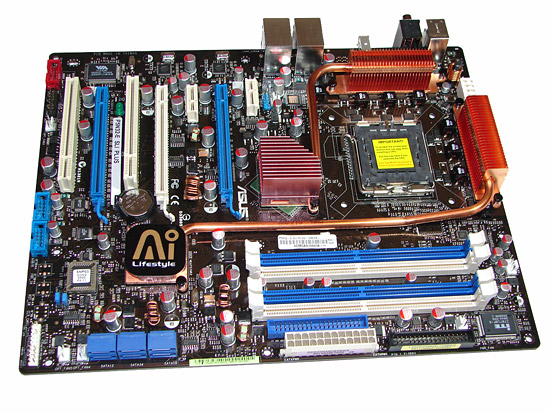ASUS P5N32-E SLI Plus: NVIDIA's 650i goes Dual x16
by Gary Key on April 2, 2007 3:30 AM EST- Posted in
- Motherboards
Board Layout and Features
Considering the amount of options on the board, we think ASUS devised a very good board layout, although a couple of areas are crowded. The board features an eight-phase power design and 100% use of conductive polymer aluminum capacitors that provided excellent stability during testing. The board also features a toned down version of the Striker Extreme passive cooling system and ASUS's patented Stack Cool 2 technology that is designed transfer heat away from the CPU area. During our overclocking tests we found the passive heat pipe cooling system worked well but required additional airflow across 650i SPP and VRM heatsinks to ensure stability with our Tuniq 120 air cooler.
There are eight fan headers (one 4-pin, seven 3-pin) located in easy to reach positions on the board. Only the CPU fan and four chassis fan headers offer automatic fan control capabilities within the BIOS. The automatic control system includes a choice of using temperature ranges or duty cycle speeds to control the selected fan headers while all fan headers are monitored by the BIOS. The board installed easily into our Cooler Master CM Stacker 830 case and cable management was very good for power, optical, and hard drives. We did find that a user could potentially disengage the SATA cables with very little pressure being applied to the cable, due to the motherboard's SATA connector design/location.

The memory slots are color coded correctly for dual channel operation. The 24-pin ATX power connector is conveniently located with the black floppy drive cable on the edge of the board. We would have switched the location of the blue IDE connector with the floppy drive connector and given it a right angle design to match the SATA ports. As it stands, this is one of the worst design decisions on the board as connecting an IDE cable after the power cable is attached is difficult once the board is installed in a case.

The six blue SATA ports are located on the edge of the board. We found the positioning of the SATA ports to be very good when utilizing the PCI or second blue PCI-E x16 physical slot. The MCP is passively cooled and remained warm to the touch throughout testing although additional cooling was not needed when overclocking.

The board comes with three PCI Express x16 connectors (two x16 and one x8 electrical), two PCI Express x1, and two PCI 2.2 connectors. The layout of this design offers a very good triple x16 connector design. The second PCI Express x1 slot will be physically unavailable as will the second PCI connector if you utilize SLI with double slot cards. The third x16 slot can be utilized for physics acceleration if this option ever arrives from NVIDIA, or it can be used as a normal PCI Express slot for a wide variety of cards up to x8 speeds.

Getting back to CPU socket area, we find a fair amount of room for alternative cooling solutions. We utilized the stock heatsink/fan in our normal testing but also verified a few larger Socket-775 air cooling solutions such as the Tuniq 120 would fit in this area during our overclocking tests. The 650i SPP chipset is passively cooled with a mid-rise heatsink unit that did not interfere with any installed peripherals but did run hot without additional airflow over it during overclocking. The VRM components are passively cooled and the 8-pin ATX power connector is located out of the way. We will start providing thermal results of the various cooling solutions in our next article.

The rear panel contains the standard PS/2 mouse and keyboard ports, two LAN ports, and four USB 2.0 ports. The LAN (RJ-45) ports have two LED indicators representing Activity and Speed of the connection through the Marvell Gigabit PCI-E PHY controllers. The panel also has an S/PDIF optical out port, S/PDIF coaxial out port, and an IEEE 1394 port.
The audio subsystem is based on the ADI AD1988B and offers 8-channel output along with full DTS Connect support. The AD1988B chipset and output ports are located on a separate riser card that ASUS has dubbed the SupremeFX. While this audio solution will not offer supreme performance over the Creative X-FI series, it certainly offers better performance and audio quality than the Realtek solutions, especially when comparing EAX 2.0 audio quality.
Overall, the feature set on this board is very good and certainly better than the EVGA 680i LT SLI board we recently reviewed, with both boards retailing for a similar price.
 |
| Click to enlarge |
Considering the amount of options on the board, we think ASUS devised a very good board layout, although a couple of areas are crowded. The board features an eight-phase power design and 100% use of conductive polymer aluminum capacitors that provided excellent stability during testing. The board also features a toned down version of the Striker Extreme passive cooling system and ASUS's patented Stack Cool 2 technology that is designed transfer heat away from the CPU area. During our overclocking tests we found the passive heat pipe cooling system worked well but required additional airflow across 650i SPP and VRM heatsinks to ensure stability with our Tuniq 120 air cooler.
There are eight fan headers (one 4-pin, seven 3-pin) located in easy to reach positions on the board. Only the CPU fan and four chassis fan headers offer automatic fan control capabilities within the BIOS. The automatic control system includes a choice of using temperature ranges or duty cycle speeds to control the selected fan headers while all fan headers are monitored by the BIOS. The board installed easily into our Cooler Master CM Stacker 830 case and cable management was very good for power, optical, and hard drives. We did find that a user could potentially disengage the SATA cables with very little pressure being applied to the cable, due to the motherboard's SATA connector design/location.

The memory slots are color coded correctly for dual channel operation. The 24-pin ATX power connector is conveniently located with the black floppy drive cable on the edge of the board. We would have switched the location of the blue IDE connector with the floppy drive connector and given it a right angle design to match the SATA ports. As it stands, this is one of the worst design decisions on the board as connecting an IDE cable after the power cable is attached is difficult once the board is installed in a case.

The six blue SATA ports are located on the edge of the board. We found the positioning of the SATA ports to be very good when utilizing the PCI or second blue PCI-E x16 physical slot. The MCP is passively cooled and remained warm to the touch throughout testing although additional cooling was not needed when overclocking.

The board comes with three PCI Express x16 connectors (two x16 and one x8 electrical), two PCI Express x1, and two PCI 2.2 connectors. The layout of this design offers a very good triple x16 connector design. The second PCI Express x1 slot will be physically unavailable as will the second PCI connector if you utilize SLI with double slot cards. The third x16 slot can be utilized for physics acceleration if this option ever arrives from NVIDIA, or it can be used as a normal PCI Express slot for a wide variety of cards up to x8 speeds.

Getting back to CPU socket area, we find a fair amount of room for alternative cooling solutions. We utilized the stock heatsink/fan in our normal testing but also verified a few larger Socket-775 air cooling solutions such as the Tuniq 120 would fit in this area during our overclocking tests. The 650i SPP chipset is passively cooled with a mid-rise heatsink unit that did not interfere with any installed peripherals but did run hot without additional airflow over it during overclocking. The VRM components are passively cooled and the 8-pin ATX power connector is located out of the way. We will start providing thermal results of the various cooling solutions in our next article.

The rear panel contains the standard PS/2 mouse and keyboard ports, two LAN ports, and four USB 2.0 ports. The LAN (RJ-45) ports have two LED indicators representing Activity and Speed of the connection through the Marvell Gigabit PCI-E PHY controllers. The panel also has an S/PDIF optical out port, S/PDIF coaxial out port, and an IEEE 1394 port.
The audio subsystem is based on the ADI AD1988B and offers 8-channel output along with full DTS Connect support. The AD1988B chipset and output ports are located on a separate riser card that ASUS has dubbed the SupremeFX. While this audio solution will not offer supreme performance over the Creative X-FI series, it certainly offers better performance and audio quality than the Realtek solutions, especially when comparing EAX 2.0 audio quality.
Overall, the feature set on this board is very good and certainly better than the EVGA 680i LT SLI board we recently reviewed, with both boards retailing for a similar price.










37 Comments
View All Comments
JarredWalton - Monday, April 2, 2007 - link
Sorry - just an errant typo correction. If you look at the image, you can see it's 1T. Gary had "TT" in there and I corrected that to 2T when it should have been 1T.yacoub - Monday, April 2, 2007 - link
oh awesome :)mostlyprudent - Monday, April 2, 2007 - link
I think it's time for a comprehensive article to pick the best boards for Intel CPUs (P965 vs. 680i vs. 650i vs. 680i LT vs. 975X vs. RD600, etc.). I know some of this has been done in pieces, but it would sure be nice to have it all in one article. Please :)Gary Key - Monday, April 2, 2007 - link
After I finally complete the opus known as uATX or "How to kill the reviewer", we will have a performance roundup that might even include a new spin of the P35. ;-)yacoub - Monday, April 2, 2007 - link
It'd be awesome to see a round-up in time for the April 22nd Intel price drop and 6320/6420 release.I want to know simply: "The Best 650 SLI and 680 SLI NVidia-based Boards For 6320/6420 OverClocking" and NOT with any of that ridiculously over-priced Dominator or Flex XLC RAM. Just test with realistic RAM that actual people would buy like Corsair XMS2 or OCZ Platinum series and similar. High-end RAM but not retarded over-priced stuff with gigantic cooling mechanisms. Test RAM that's around $250 (or less) for 2GB matched pairs.
That's what I'd like to see. An actual overclocker 650/680 board round-up for the 6320/6420 c2d chips with RAM people who are looking for the best bang-for-the-buck would actually buy.
People who spend around $200-250 for the motherboard, $200-250 for quality, low-latency RAM, and $200 for the CPU.
There's a lot of us and we'd love to know which board to buy and which RAM works best with it when oc'ing.
sWORDs - Tuesday, April 3, 2007 - link
The OCZ2N1066SR2GK only costs €208 here, that's SLI ready, 1066 MHz, 5-5-5-15, 2x 1GB.The OCZ2N900SR2GK only costs €192 here, that's SLI ready, 900 MHz, 4-4-3-15, 2x 1GB.
yacoub - Monday, April 2, 2007 - link
This image link on page4 is different than the actual image:http://images.anandtech.com/reviews/motherboards/a...">http://images.anandtech.com/reviews/mot...sus/p5n3...
http://images.anandtech.com/reviews/motherboards/a...">http://images.anandtech.com/reviews/mot...sus/p5n3...
(I think one of the sample images is duplicated.)
JarredWalton - Monday, April 2, 2007 - link
Did someone fix this? They are definitely different images for me, although only minor differences.Marlowe - Monday, April 2, 2007 - link
Very nice review - looks like a good board! After reading the article I have some questions:Isn't the 'Plus' moniker ment to mean some kind of functionality with Vista? I think I remember when some previous Asus board got a new revision and the got the Plus moniker, it also got a small PCB riser board attached below the IO area.. ReadyBoost or something? Does this board have that? It's not that copper square behind the LAN/USB connections? Or maby it's just a new name for their mid-range boards.
Isn't that a 6-phase power circuit in the pics? I know the Asus site claims 8-phase, but they also have a wrong power circuit pic. The site also says "With the highest speed up to 800MHz," about the memory speed and doesn't mention support for EPP at all, so that must be wrong as well according to your article?
In the expansion slot area you write "two PCI Express x1" but that's not so? Isn't the top slot for the "SupremeFX" audio riser board?
In the Dual Core OC page, the E6300 has 2MB L2 not 4MB :)
And a question: I have the Tuniq120 as well, and the fan is placed ~7 cm over the board and placed in an angle so I guess there aren't much airflow going to those heatpipe sinks. Did you have to use an additional fan over the cpu area while using the Tuniq120 heatsink and overclocking? So if overclocking you *have* to hang some fan with zip ties or something over that area? Thats a bit of a hassle isn't it :P
Anyways very nice performing board :D Looks physically totally identical to the Asus P5N32-E SLI tho :D But
sWORDs - Tuesday, April 3, 2007 - link
The E Plus is ment as an upgrade to the E, it has all solid caps just as the Striker.The E, E Plus and Striker all use the same PCB (just look under the white sticker) and all have a 8 phase power design.
All three have EPP and SLI Ready support up the 1200 (and the 1250 works as well).
The top one can only be used for the riser.
True.
The Northbridge does get very hot, however using the heatpipes should be enough to reach 450. Any busspeed above 400 isn't recommended anyway because of the reduction of timing from the strap selection.
True, they share the same PCB, this one has the same caps as the Striker.